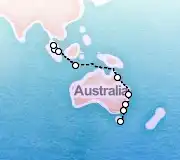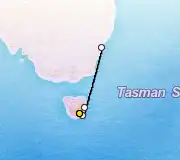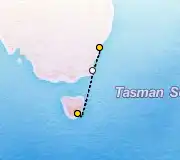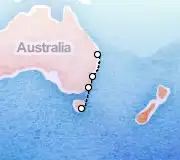The Port of Hobart is located on the estuary of the River Derwent, nestled beneath the imposing presence of kunanyi / Mount Wellington. As the deepest sheltered harbour in the Southern Hemisphere, it is a significant port for both commercial shipping and scientific research, serving as a key gateway for Antarctic expeditions.
For cruise passengers, Hobart offers a stunning arrival with its blend of natural beauty and historic architecture. The port's central location allows for immediate immersion into Tasmania's vibrant capital city, making it a popular and convenient stop on Australian cruise itineraries.
For panoramic views of the city and harbour, a trip to the summit of kunanyi / Mount Wellington is a must. The peak is about a 30-40 minute drive from the port, and the weather can be dramatically different from the city below.
The Museum of Old and New Art (MONA) is a world-renowned institution featuring a provocative and eclectic collection. It is best reached via a 25-minute scenic ferry ride from the Brooke Street Pier near the cruise terminal.
If your visit falls on a Saturday, the famous Salamanca Market is an unmissable experience. Located just a few steps from the cruise pier, this vibrant outdoor market features hundreds of stalls selling local produce, arts, crafts, and food.
Last updated on June 22, 2025
A popular day trip is to the Port Arthur Historic Site, a former convict settlement and UNESCO World Heritage site. Located on the Tasman Peninsula, it is approximately a 90-minute drive from Hobart and offers a profound glimpse into Australia's colonial past.
Closer to Hobart is the charming historic town of Richmond, about a 30-minute drive away. It is famous for its well-preserved Georgian architecture, including the oldest bridge still in use in Australia, making for a pleasant half-day excursion.
Last updated on June 22, 2025
The Hobart cruise port, Macquarie Wharf, is ideally situated directly in the heart of the city's historic waterfront. Cruise ships dock just a short, flat walk from the central business district and key attractions like Salamanca Place and Constitution Dock.
No shuttles are necessary to reach the city center, as it is immediately accessible on foot. The pier area is part of the bustling waterfront, which is lined with restaurants, cafes, galleries, and shops, making it an attraction in its own right. Ships typically dock directly, so tendering is not required.
Last updated on June 22, 2025
The local currency is the Australian Dollar (AUD). US dollars or other foreign currencies are not typically accepted for transactions, so it is necessary to use local currency or credit cards.
ATMs are widely available throughout the city center, including near the cruise terminal, for easy cash withdrawals. Major credit cards like Visa and Mastercard are accepted in most shops, restaurants, and tourist attractions.
Last updated on June 22, 2025
Hobart is considered a very safe city with a low crime rate, making it ideal for independent exploration. Standard safety precautions that you would practice in any city are recommended, such as being aware of your surroundings and keeping valuables secure.
There are no specific areas that tourists need to avoid within the city center or surrounding suburbs. Exploring on foot is generally safe and enjoyable. While guided tours are great for structured sightseeing, visitors should feel confident wandering through the main tourist areas on their own.
Last updated on June 22, 2025
Hobart has a temperate maritime climate, well-known for its changeable weather where you can experience 'four seasons in one day'. The main cruise season occurs during Australia's summer (December to March), which brings mild to warm conditions.
During this period, average daytime temperatures range from 18°C to 23°C (65°F to 73°F), though warmer days are common. It's essential to pack in layers; bring a light jacket or fleece, a waterproof layer for potential showers, and sun protection including a hat and sunscreen, as the sun can be strong.
Last updated on June 22, 2025
Hobart's city center is compact and very walkable, with most major attractions accessible on foot from the cruise pier. For destinations further afield, several options are available.
Taxis and ride-sharing services are readily available at the terminal. The public bus system, operated by Metro Tasmania, provides comprehensive coverage of the city and its suburbs, with a major bus mall located a short walk from the port. For a unique trip, a high-speed ferry to the Museum of Old and New Art (MONA) departs from the Brooke Street Pier, also within walking distance.
Last updated on June 22, 2025
Hobart offers excellent shopping opportunities, particularly for local arts, crafts, and gourmet products. The best place to start is Salamanca Place, where historic sandstone warehouses have been converted into galleries, boutiques, and studios selling everything from woodwork to fine art.
On Saturdays, the Salamanca Market is the city's premier shopping destination. Look for Tasmanian specialties such as Huon Pine products, lavender items, local woolens, and artisanal food and drinks like gin, whisky, and cheese. For more conventional shopping, the city's central business district has several malls and arcades. Prices in retail stores are fixed.
Last updated on June 22, 2025





No ships scheduled in port today.
Last updated on June 13, 2025
Many main attractions are within walking distance of the cruise terminal at Macquarie Wharf. For others, taxis, ride-sharing services, and local buses are readily available near the terminal.
Must-see attractions include Salamanca Place (especially its Saturday Market), the historic Battery Point, the Tasmanian Museum and Art Gallery, and a ferry trip to MONA (Museum of Old and New Art).
Try fresh Tasmanian seafood, particularly oysters and salmon, at restaurants along the waterfront near the port, or explore cafes and pubs in Salamanca Place for local produce and craft beers.
The local currency is Australian Dollar (1 USD = 1.53 AUD). ATMs are widely available in the city centre, a short walk from the port, and banks for currency exchange can be found in the main shopping areas like Elizabeth Street.
Cruises typically visit Hobart during warmer months (October to April) with average temperatures from 15-25°C (59-77°F); pack layers as weather can change quickly, including a light jacket and comfortable walking shoes.
Nearby beaches like Long Beach in Sandy Bay or Nutgrove Beach are accessible via a short bus or taxi ride (around 10-15 minutes) and offer pleasant spots for a stroll.
Popular shore excursions include trips to MONA, historic Port Arthur, Bonorong Wildlife Sanctuary, or kunanyi / Mount Wellington; both cruise line and independent tours are available, with independent options often providing more flexibility.
Salamanca Market (Saturdays) offers unique local crafts, art, and produce. For souvenirs, look for Tasmanian timber products, lavender items, woolens, or local gourmet foods and wines.
Consider a day trip to the historic town of Richmond (25 mins drive), the penal settlement of Port Arthur (90 mins drive), or explore the natural beauty of Bruny Island via ferry.
Hobart is Australia's second-oldest capital city, established in 1804, and is shadowed by the impressive kunanyi / Mount Wellington, which significantly influences its weather.
On average Hobart is rather affordable compared to other ports. The diagram below shows the monthly average cost per day for cruises from Hobart. Prices are roughly the same throughout the year.
Want to hear about the best deals and cruise tips every week? Sign up for our free weekly VIP Newsletter, customized exactly to your preferences!